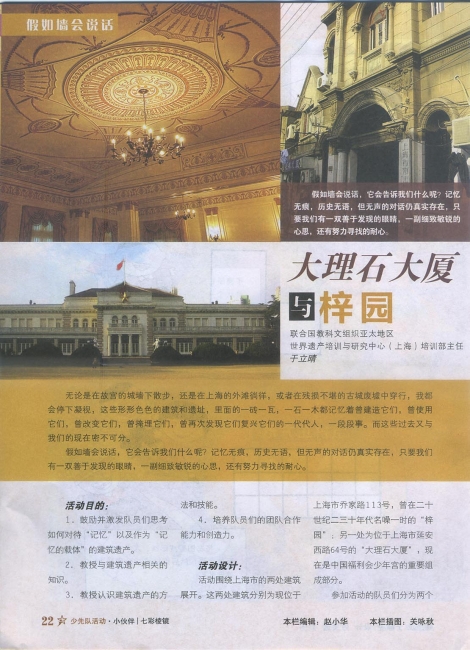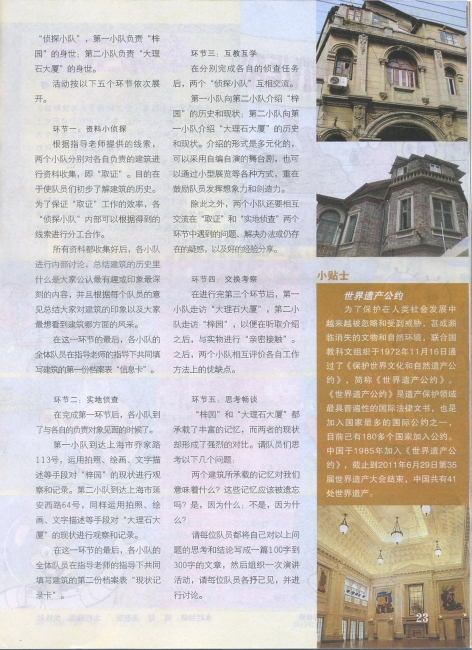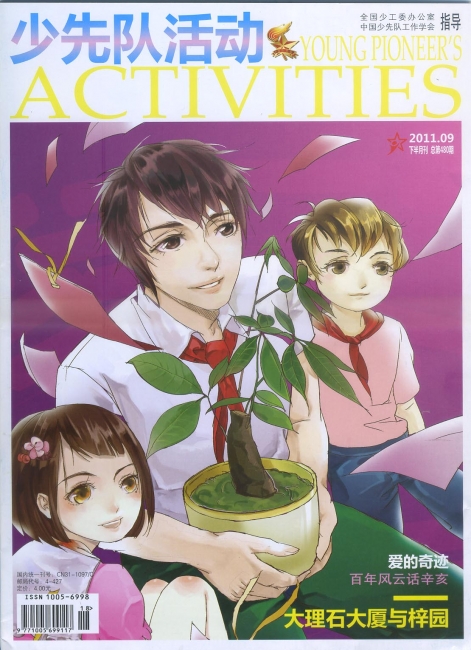| A New Specialty Column in Magazine Promotes the Study of Heritage to Teenagers |
| From:WHITRAP Shanghai Author:YU Liqing PublishDate:2011-10-25 Hits:12925 |
|
FIRST STAGE ACTIVITY Purpose Participants in the activities are divided into two "detective teams”. The first team is responsible for the story of the "Chinese Catalpa Garden" and the second team is is to uncover the history of the “Marble Mansion"’. There are five parts to this activity. Part 1: Little Detective Using clues provided by the teacher, the two teams will collect materials related to the architectural history behind the sites, designated as “gathering evidence” to grasp an overall knowledge of the history of the architecture. In order to ensure efficiency, the “detective teams" should share their work and help one another according to the clues provided. Part 2: Field Investigation After the first step, each team is to meet at the architectural site they have been assigned to... Part 3: Collective Learning and Teaching After finishing the “detective missions”, the two "detective teams" should discuss and exchange information. Part 4: Exchange Visits After finishing the three parts above, the first team should visit the “Marble Mansion" and the second team the “Catalpa Garden" in an exchange to get a more “intimate contact” with the architecture after listening to the introduction. Then the two teams should evaluate each other for their respective advantages and disadvantages of the working method.Part 5: Think and Talk "Chinese Catalpa Garden" and the "Marble Mansion" both carry rich memories while their respective states are now in sharp contrast: one is forgotten by people, gradually fading in the collective memory while the other remains new and vibrant throughout the passage of time. This might raise the following questions worth thinking about: 1. What do the memories carried down by the two architectural sites mean to us? Can those memories be forgotten? Why and why not? 2. Can we choose to remember or to forget? If we choose to remember, how can we retain the remembered? Through which forms can that be transmitted? Each team member should write down their thinking about the above questions in an essay (between 100 and 300 words) in addition to a speech explaining their own point of view. This might be followed by a group discussion later. Activity Award: The essays written by each team will be uploaded to the websites of UNESCO Asia-Pacific Heritage training and Research Center (Shanghai) and China Junior Welfare Center. Among those, the best ones will be published in the "Young Pioneers Activities" magazine.Tips: the “World Heritage Convention" For the purpose of protecting cultural relics and natural environments which have been increasingly ignored and threatened or even endangered with the development of human civilization, UNESCO passed “the convention of the protection of the world cultural and natural heritage", simplified as the "World Heritage convention" on November 16, 1972. This is the most universal legal document in the field of heritage protection and also one of the conventions with the largest number of member states with more than 180 countries acceded. In 1985, China joined the" World Heritage convention". By the end of the thirty-fifth session of the World Heritage Convention on June 29, 2011, China has a total of 41 world heritage sites recognized.
  |
|
|
- Call for Application | 2024 Global Awards for World Heritage Education Innovative Cases(AWHEIC) Promoting what people do and how they do it
- Documentary: 2023 World Heritage Creative X Innovators Conference and the AWHEIC Third Anniversary Celebration
- Publication | WHITRAP Newsletter No. 61
- Mt. Huangshan first show in Climate Action for World Heritage
- Call for Good Practices: 2024 Environment and Resilience
- FAQs | 2024 Call for Good Practices
Copyright © 2009-2012 World Heritage Institute of Training and Research-Asia and Pacific (shanghai)



